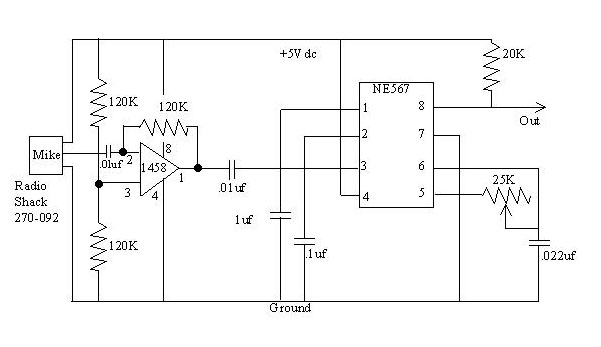
Sound Activation
To get a 5% reduction in time, a robot may be initiated by a sound rather than a manual action. The rules for the Trinity contest define this as a 3 to 4 KHz tone of which the Radio Shack #273-075 piezo buzzer is an example.
The circuits below cover the sound generator itself; and the detection of the sound and output of a signal to input to the robotís processor.

The tone generator is easily built by connecting a 9 volt battery to the buzzer through a momentary switch. I believe the unused blue wire was to give a pulsing tone.
The detector (below) is a bit more complex. It amplifies a microphone and sends the resulting signal to an NE567 tone decoder.
The amplifier is half of a 1458 opamp. The two 120K resistors attached to pin 3 keep the opamp's average output at about halfway between the 5 vdc source and ground. These resistor values are non-critical, but should be equal.
The 120K feedback resistor from pin 1 to 2 establishes the gain of the amplifier and the sensitivity of the detector to a generated tone. I found that 120K gave me pretty reliable operation at about with the generator about 3 feet from the microphone. You can vary this resistor to make the detector more or less sensitive if you wish. More resistance makes it more sensitive.
The two 0.01 uf capacitors are just to eliminate dc voltages. Their values are non-critical.
The 567 works by comparing the input signal to an internal oscillator whose frequency is determined by the 25K variable resistor and the 0.022 uf capacitor. You vary these components as necessary to get the oscillator at the same frequency as your tone generator. I used a 10 turn pot for the 25K which worked fine. The resulting resistance to match my tone generator was about 11K. The 567 requires a pretty close frequency match to trip (the output goes low when the frequencies match). I find that I occasionally have to readjust the 25K resistor to get a reliable trip. You might want to make this adjustment accessible if you package the circuit.
The 20K pullup resistor on the output can be changed or deleted to match your processor's requirements.
The 1uf and 0.1uf capacitors provide some filtering and bandwidth adjustment. See the application notes if you want to adjust them.
Data on the NE567 can be found at http://www-us6.semiconductors.com/pip/ne567d (or if this link becomes obsolete, search for "Phillips Semiconductors")
The 1458 is available at Radio Shack and many other sources..
